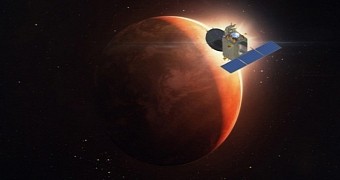Should things go according to plan, a spacecraft launched by the Indian Space Research Organization towards the end of last year will start orbiting Mars before this month comes to an end.
The spacecraft in question, dubbed Mangalyaan, left Earth on November 4, 2013, and is expected to reach its destination this coming September 24.
Should the spacecraft make it all the way to the Red Planet and start orbiting it, this space endeavor will officially become the first successful Mars mission to have until now been launched by an Asian nation.
The Indian spacecraft's bio
According to Nature, this spacecraft, whose official name is the Mars Orbiter Mission (MOM, for short) took about 15 months to piece together. Some say that, given its career goals, researchers would have done well to spend some more time working on it.
“A significant gestation period would have ensured proper engineering rigor and maximized the chances of success,” Amitabha Ghosh, an Indian-born planetary scientist who now works in the US, said in a statement.
Information shared with the public shows the spacecraft carries a total of 5 instruments whose combined weight amounts to merely 15 kilograms (a little over 33 pounds). Rumor has it that Mangalyaan had to be this slim to ensure the success of the launch.
Thus, the spacecraft was sent on its way with the help of a rocket known as the Polar Satellite Launch Vehicle (better known as PSLV). This spacecraft usually serves to carry satellites into our planet's low orbit, and is therefore rather low-power.
According to specialists with the Indian Space Research Organization, the scientific instruments aboard Mangalyaan will enable the spacecraft to study the Red Planet's surface and collect information concerning the makeup of Martian soils and atmosphere.
For the time being, the Indian spacecraft is in sleep-mode so as to preserve energy and reduce wear and tear. Mangalyaan is expected to wake up from its slumber sometime in the days to come and get its engines up and running. The spacecraft must then position itself in Mars' orbit.
Not the coolest spacecraft on the block
Just a few days before the Indian spacecraft is scheduled to reach its destination, the Red planet will receive yet another visitor: a space probe launched by the National Aeronautics and Space Administration in the US in November 2013 two weeks before Mangalyaan left Earth.
This probe, known as Mars Atmosphere and Volatile Evolution (MAVEN), packs 3 more scientific instruments, and its working agenda is a wee more complex and impressive. Thus, this space probe will try and collect data indicating how solar winds have transformed the Martian atmosphere in time. Simply put, MAVEN pretty much trumps Mangalyaan when it comes to coolness.
Then again, the Indian spacecraft has one other very important mission that it will undoubtedly accomplish: prove to the world that India's space program is not child's play. As Amitabha Ghosh put it, “It will be a validation that Indian research and development has come of age.”

 14 DAY TRIAL //
14 DAY TRIAL //